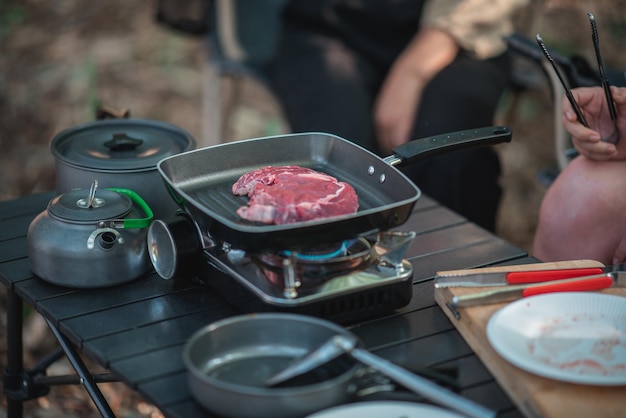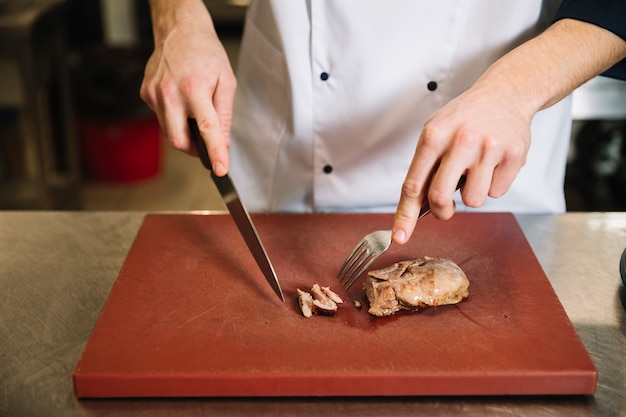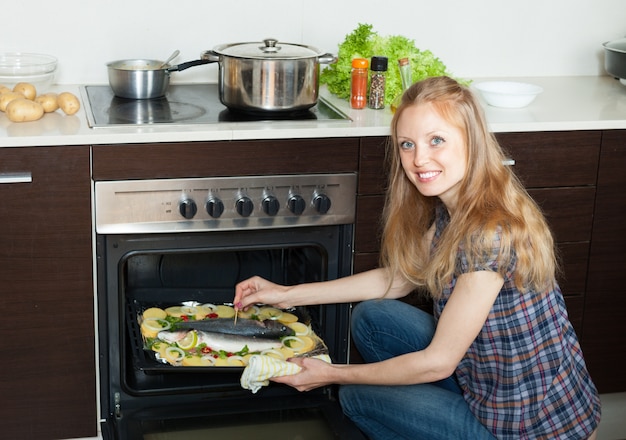Let's be honest: there's nothing quite like a perfectly cooked steak. That juicy, flavorful centre, the satisfying sear on the outside – it's a culinary masterpiece that never fails to impress. But getting that perfect steak isn't always a piece of cake. I've had my fair share of mishaps – steaks so dry they could have been used as sandpaper, others so raw they could still moo. But through trial and error, I've finally cracked the code, and I'm here to share my secrets with you.
This guide will take you through the process of cooking a steak to perfection on the stovetop, covering everything from choosing the right cut to mastering the flip. We'll dive deep into the different levels of doneness, nail those cooking times, and even tackle some common mistakes you might encounter. So, grab your favourite pan, a trusty thermometer (a must-have!), and let's get cooking!
(Part 1) Picking the Perfect Steak

It All Starts with the Cut
The journey to a fantastic steak begins with choosing the right cut. There's a vast world of cuts out there, each with its unique flavour and texture. If you're aiming for a steak that's juicy and tender, you can't go wrong with a ribeye, new york strip, or filet mignon. These cuts are known for their marbling, which translates to rich flavour and melt-in-your-mouth tenderness. For those who prefer a little more chew and a bolder flavour, sirloin or chuck eye steaks are excellent choices. Personally, I'm a sucker for a good ribeye – the marbling just adds so much depth to the flavour.
Thickness Matters
When it comes to steak thickness, aim for a cut that's at least 1 inch thick. This allows for a more even cooking process, ensuring that the centre reaches the desired doneness without overcooking the exterior. Thicker steaks might require a little more time on the stove, so be sure to keep that in mind. I find that a 1.5-inch steak is the sweet spot – it cooks up beautifully, with a nice, juicy centre and a delicious sear.
Don't Forget About Quality
The quality of the steak plays a huge role in the final outcome. Look for meat that's properly aged – this develops flavour and tenderness. You can often find quality cuts at your local butcher, who can also give you advice on which cuts are best for your needs. I've found that a good butcher can make a world of difference – they're like steak whisperers! They know their meat and can recommend the perfect cut for your cooking style and preferences.
(Part 2) Preparing the Steak

Let It Come to Room Temperature
Before you start cooking, take your steak out of the fridge and let it sit at room temperature for about 30 minutes. This allows the steak to cook more evenly. It might seem counterintuitive to bring cold meat to room temperature, but it really makes a difference! The steak will cook more evenly throughout, resulting in a more tender and flavorful final product.
Season It Right
Salt and pepper are your best friends when it comes to seasoning steak. Season generously on both sides just before cooking. I like to use a good quality sea salt and freshly ground black pepper, but feel free to experiment with other herbs and spices like garlic powder, onion powder, or paprika. A pinch of dried rosemary or thyme can also add a lovely aroma to your steak. Just remember, less is more! You don't want to overpower the natural flavour of the steak.
Oil Up
A good drizzle of olive oil or vegetable oil is all you need to create that beautiful sear on your steak. Just before cooking, rub the oil all over the steak, making sure to get into all the nooks and crannies. This will help the steak to brown beautifully and prevent it from sticking to the pan.
(Part 3) Cooking Time and Doneness

Know Your Temperatures
Here's a quick breakdown of the different levels of doneness for steak, based on internal temperatures. Using a meat thermometer is essential for getting the perfect level of doneness. It eliminates guesswork and ensures that your steak is cooked to your liking.
| Doneness | Internal Temperature (°F) | Internal Temperature (°C) |
|---|---|---|
| Rare | 125-130 | 52-54 |
| Medium-Rare | 130-135 | 54-57 |
| Medium | 140-145 | 60-63 |
| Medium-Well | 150-155 | 65-68 |
| Well-Done | 160 | 71 |
I personally prefer a medium-rare steak, but ultimately, it's all about your taste. Experiment with different levels of doneness until you find what you like best. There's no right or wrong answer when it comes to steak cooking!
Mastering the Flip
One of the most crucial parts of cooking a steak is the flipping. For a perfect sear, you want to cook each side for a specific amount of time without disturbing the steak. Here's a general guideline for cooking times based on thickness:
- 1-inch steak: 3-4 minutes per side
- 1.5-inch steak: 4-5 minutes per side
- 2-inch steak: 5-6 minutes per side
Remember, these are just guidelines. The actual cooking time will depend on factors such as the heat of your pan and the thickness of the steak. Keep an eye on your steak and adjust the cooking time accordingly. The best way to gauge doneness is to use a meat thermometer. When the steak reaches your desired internal temperature, it's ready to be flipped.
Once you've cooked the steak for the desired time on each side, you can add any additional ingredients you'd like, such as butter, garlic, or herbs, to create a flavourful sauce. I love to add a knob of butter to the pan during the last minute of cooking. The butter melts and creates a delicious, aromatic sauce that enhances the flavour of the steak.
(Part 4) Resting is Key
After cooking, let your steak rest for 5-10 minutes before slicing. This allows the juices to redistribute throughout the steak, resulting in a more tender and flavorful cut. I often use this time to prepare my sides, and it's a good reminder to give the steak a break.
(Part 5) Common Mistakes to Avoid
Let's face it, even the most seasoned cooks can make a few mistakes when it comes to steak. Here are some common pitfalls to avoid:
Overcrowding the Pan
If you cram too many steaks into your pan, it will lower the temperature and prevent them from getting a good sear. Cook your steaks in batches if necessary, ensuring that they have ample space to breathe. This will ensure that each steak gets a beautiful sear and cooks evenly.
Moving the Steak Too Much
Resist the urge to constantly move your steak around the pan. Let it sit undisturbed for the allotted time on each side. This will help to create a beautiful sear and prevent the steak from becoming tough. Only flip the steak once, when it's ready to be turned over.
Not Using a Thermometer
A meat thermometer is your best friend when it comes to cooking steak. It ensures that your steak is cooked to your desired doneness and prevents overcooking. I always recommend investing in a good quality thermometer, it's a game-changer! It takes the guesswork out of cooking and gives you the confidence to cook the perfect steak every time.
Using the Wrong Pan
A heavy-bottomed pan, such as a cast iron skillet or a stainless steel pan, is ideal for cooking steak. These pans retain heat well, which is crucial for achieving a beautiful sear. Avoid using non-stick pans, as they can warp under high heat and may not be suitable for searing.
Not Searing Properly
To achieve a perfect sear, make sure your pan is very hot. Let the oil shimmer before adding the steak. Don't crowd the pan with too many steaks. If you do, the pan will cool down, and you won't get a good sear.
(Part 6) steak sauces: A Touch of Magic
A steak is already delicious on its own, but a good sauce can elevate it to a whole new level. Here are a few of my favourite steak sauce combinations:
Garlic Butter Sauce
Simple, yet so flavorful. Melt some butter in a pan, add a few cloves of minced garlic, and cook until fragrant. Drizzle the sauce over your steak and enjoy! The rich, buttery sauce with a hint of garlic is the perfect complement to a juicy steak.
Mushroom Sauce
For a richer, more umami-filled sauce, sauté some sliced mushrooms with onions and garlic in butter. Add a splash of red wine or broth, and simmer until thickened. Pour the sauce over your steak for a truly satisfying experience. The earthy flavour of the mushrooms pairs beautifully with the steak.
Peppercorn Sauce
This sauce packs a punch with its peppery kick. Combine cracked black peppercorns with butter, and cook until the peppercorns are fragrant. Add a splash of brandy or wine, and simmer until thickened. The perfect sauce for those who like a little heat.
Béarnaise Sauce
A classic French sauce made with egg yolks, butter, and tarragon. This sauce is rich and creamy, with a subtle herb flavour. It's a perfect match for a medium-rare steak.
(Part 7) The Ultimate Stovetop steak recipe
Here's a step-by-step recipe for the perfect stovetop steak:
Ingredients:
- 1 (1-inch thick) ribeye steak
- 1 tablespoon olive oil
- 1 teaspoon sea salt
- 1/2 teaspoon freshly ground black pepper
- 2 tablespoons butter
- 2 cloves garlic, minced
- 1 tablespoon chopped fresh parsley
Instructions:
- Take the steak out of the refrigerator and let it sit at room temperature for 30 minutes.
- Heat a heavy-bottomed pan over medium-high heat. If using a cast iron skillet, preheat it in the oven for 10 minutes at 400°F (200°C) for even better results.
- Season the steak generously with salt and pepper on both sides. Use a good quality sea salt and freshly ground black pepper for the best flavour.
- Add the olive oil to the pan. Once the oil is shimmering, carefully place the steak in the pan. Make sure the pan is hot enough before adding the steak to achieve a beautiful sear.
- Cook the steak for 3-4 minutes per side, without moving it, for a beautiful sear. Avoid poking or prodding the steak while it's cooking, as this will release the juices and make the steak tougher.
- Add the butter to the pan, and swirl it around to create a sauce. The butter will melt and create a delicious, aromatic sauce that will enhance the flavour of the steak.
- Add the minced garlic and cook for 1 minute, stirring constantly. The garlic will infuse the butter sauce with a delicious flavour.
- Carefully remove the steak from the pan and place it on a cutting board. Let it rest for 5-10 minutes. This allows the juices to redistribute throughout the steak, resulting in a more tender and flavorful cut.
- While the steak is resting, pour the sauce over the steak, and sprinkle with chopped parsley. This adds a fresh, vibrant flavour to the steak.
- Slice the steak against the grain and serve immediately. This will ensure that the steak is tender and juicy. Serve with your favourite sides, such as mashed potatoes, roasted vegetables, or a green salad.
(Part 8) FAQs
What if I overcook my steak?
Don't panic! Even if you've overcooked your steak, there are ways to salvage it. If it's just slightly overcooked, it should still be edible. However, if it's very dry, you can try adding a sauce or gravy to help moisten it. You can also slice it thinly and use it in a stir-fry or salad. Remember, even overcooked steak can be delicious! Experiment with different ways to use it.
How long should I cook a steak for different levels of doneness?
Cooking times vary depending on the thickness of the steak and the desired level of doneness. Use a meat thermometer to ensure accuracy. As a general guideline, a 1-inch steak cooked to medium-rare will take about 3-4 minutes per side, while a well-done steak will take about 5-6 minutes per side. For thicker steaks, adjust the cooking time accordingly. Remember, every steak is different. Don't be afraid to adjust the cooking times based on your steak's thickness and your desired level of doneness.
What's the best way to store leftover steak?
Store leftover steak in an airtight container in the refrigerator for up to 3 days. You can reheat it in a pan or microwave, or use it in a salad, sandwich, or soup. Remember to slice the steak before storing it, as this will allow it to cool more quickly.
What are some tips for getting a good sear on my steak?
To achieve a beautiful sear, make sure your pan is very hot. Use a heavy-bottomed pan, and let the oil shimmer before adding the steak. Don't move the steak around too much. Let it sit undisturbed for the allotted time on each side to allow the crust to form. This will help to lock in the juices and create a delicious, crispy crust.
Can I cook steak in a cast iron skillet?
Absolutely! cast iron skillets are excellent for cooking steak. They retain heat well, ensuring a nice even sear. Just make sure to preheat your skillet over medium-high heat before adding the steak. For even better results, preheat the skillet in the oven for 10 minutes at 400°F (200°C).
And there you have it! Now that you've armed yourself with these tips and tricks, go forth and conquer the world of steak cooking. Remember, it's all about practice and experimentation. Don't be afraid to try different cuts, seasonings, and sauces to find your perfect steak recipe. Happy grilling!
Everyone is watching

How to Cook Frozen Lobster Tails Perfectly: A Step-by-Step Guide
RecipesLobster. Just the word conjures up images of lavish meals, special occasions, and a taste of luxury. But let's...

Pigs in a Blanket Cooking Time: How Long to Bake for Perfect Results
RecipesAh, pigs in a blanket. Just the name conjures up images of those delightful little parcels of crispy pastry en...

Pork Fillet Cooking Time: How Long to Cook It Perfectly
RecipesPork fillet, or tenderloin as it's sometimes called, is a real favourite in our house. It's so versatile, and...

The Ultimate Guide to Cooking Delicious Frankfurters
RecipesLet's face it, we all love a good frankfurter. It's a classic, simple, and always satisfying. But let's be rea...

Wolf Meat Recipes: A Guide to Cooking Wild Game
RecipesLet's be honest, you don't see wolf meat at your local butcher shop every day. It's a bit of a wild card, but ...
